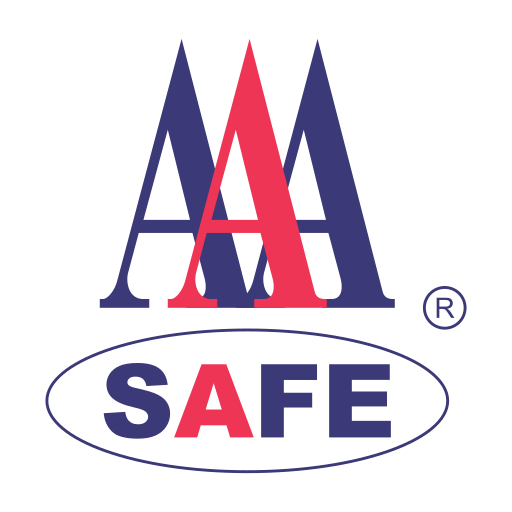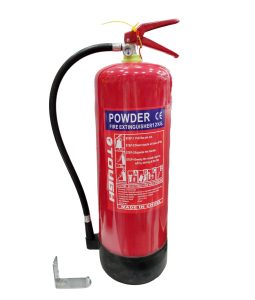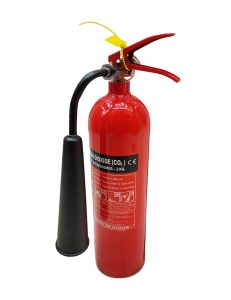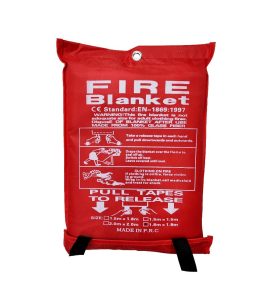Fire safety is a critical aspect of workplace management. Among the various fire safety tools available, fire blankets stand out as simple yet remarkably effective devices for combating small fires. This comprehensive guide will delve into the intricacies of fire blankets, exploring their functionality, types, applications, and crucial role in fire safety strategies.
What is a Fire Blanket?
A fire blanket is a safety device designed to extinguish incipient (starting) fires. It consists of a sheet of fire-retardant material that can be quickly and easily placed over a fire to smother it. These blankets are typically made from materials such as fiberglass, wool treated with fire-retardant chemicals, or high-tech aramid fibers like Kevlar.
Key Features of Fire Blankets
| Feature | Description |
| Material | Fire-resistant fabric (e.g., fiberglass, treated wool) |
| Size | Usually 1m x 1m or larger |
| Storage | Quick-release container for easy access |
| Usage | Smothering small fires, protecting individuals |
How Do Fire Blankets Work?
Fire blankets work on the principle of oxygen deprivation. Fire requires three elements to sustain itself: heat, fuel, and oxygen. This is known as the fire triangle. By removing any one of these elements, the fire can be extinguished. Fire blankets primarily target the oxygen component:
- Barrier Creation: When placed over a fire, the blanket creates a barrier between the flames and the surrounding air.
- Oxygen Supply Cutoff: This barrier cuts off the oxygen supply to the fire.
- Extinguishing the Fire: Without access to oxygen, the fire cannot continue to burn and will eventually go out.
Additionally, fire blankets can help in heat management:
- The fire-retardant materials used in fire blankets can absorb some of the heat from the fire.
- This heat absorption helps prevent the fire from spreading to nearby objects.
Top Reasons to Keep Fire Blankets at Your Workplace
1. Effective Against Small Fires
Fire blankets are highly effective in extinguishing small fires, particularly in their early stages. They are ideal for:
- Class A fires: Ordinary combustibles like wood, paper, and cloth.
- Class F fires: Cooking oils and fats.
For example, in a workplace kitchen, a small grease fire on a stovetop can quickly be smothered with a fire blanket before it has a chance to spread. Prompt action can prevent extensive damage and safeguard employee safety.
2. Easy to Use
One of the primary advantages of fire blankets is their simplicity. They:
- Require minimal training: Employees can learn to use fire blankets in a few minutes.
- Can be used by anyone in an emergency: With no complex mechanisms or instructions involved, even those with little fire safety training can effectively use a fire blanket in a crisis.
This ease of use is particularly valuable in high-stress situations where complex instructions might be difficult to follow. A new employee could effectively use a fire blanket if needed, ensuring that even in the face of panic, they can respond swiftly.
3. Versatility
Fire blankets have multiple applications in workplace safety:
Application | Description |
Kitchen Fires | Ideal for smothering grease fires. |
Electrical Fires | Safe to use on electrical equipment, provided they are rated for such use. |
Personal Protection | Can be wrapped around a person to escape through flames. |
Equipment Protection | Useful in laboratories to smother equipment fires, preventing further damage. |
For instance, in a laboratory setting, a fire blanket could be used to quickly smother a small fire on a piece of equipment, preventing damage and potential chemical reactions that could exacerbate the situation.
4. No Residue
Unlike fire extinguishers, fire blankets leave no residue after use. This is advantageous because:
- Minimizes damage to equipment and surroundings: There’s no cleanup of foam or powder, which can be detrimental to sensitive machinery or electronic devices.
Reduces cleanup time and costs after a fire incident: This is particularly beneficial in environments with sensitive equipment, such as computer server rooms or clean manufacturing areas where residue can cause malfunctions.
5. Compact and Portable
Fire blankets are easy to store and transport, which makes them ideal for various work environments:
- Can be placed in strategic locations throughout the workplace: For example, having a fire blanket in the kitchen, laboratory, or storage areas can ensure quick access in emergencies.
- Ideal for small offices or workspaces with limited storage: Their compact nature allows for placement in various locations, such as under a reception desk, in a break room, or near a laboratory workstation.
6. Cost-Effective
Fire blankets offer excellent value for their cost. They are:
- Generally less expensive than fire extinguishers: This makes them an accessible option for small businesses or startups with limited budgets.
- Have a long shelf life with minimal maintenance required: Once installed, they require little attention aside from routine inspections.
By incorporating fire blankets into safety protocols, organizations can improve their fire safety measures without straining their budgets.
7. Complement to Other Fire Safety Equipment
Fire blankets work well in conjunction with other fire safety tools. They:
- Enhance overall fire safety strategy: When used alongside fire extinguishers and smoke detectors, they provide a more comprehensive approach to fire safety.
- Provide an additional option in emergency situations: For example, in a workplace kitchen, having both a fire blanket for small grease fires and a suitable fire extinguisher for larger fires ensures comprehensive protection.
This layered approach to fire safety increases the likelihood of successfully managing and containing fire incidents.
8. Psychological Comfort
The presence of fire blankets can provide peace of mind to employees. Knowing that fire safety measures are in place:
- Increases workplace confidence: Employees feel more secure in their environment, which can positively affect overall morale and productivity.
- Demonstrates the employer’s commitment to safety: Visible safety measures can foster a culture of safety within the organization, encouraging employees to prioritize safety in their daily activities.
When employees know that they have tools at their disposal to handle emergencies, they may feel less anxious about potential fire hazards.
9. Regulatory Compliance
Many jurisdictions require fire blankets as part of workplace safety regulations. By keeping fire blankets on-site:
- Helps meet legal safety requirements: This can be crucial for avoiding potential fines or legal repercussions.
- Contributes to positive safety audits: Compliance with safety regulations not only ensures a safer workplace but also enhances the company’s reputation in the eyes of clients and stakeholders.
Having well-documented fire safety measures, including the presence of fire blankets, reflects positively during inspections and can improve a company’s standing in the community.
10. Potential Life-Saver
In critical situations, fire blankets can save lives. They can be used to:
- Smother flames on a person’s clothing: This quick action can prevent severe burns and potential fatalities.
- Provide a protective shield when escaping a fire: If employees need to evacuate a burning building, using a fire blanket to shield themselves from flames and heat can be a vital survival tactic.
For instance, if an employee’s clothing catches fire in a workshop, a nearby fire blanket could be used to quickly smother the flames, potentially preventing severe burns. Such incidents highlight the importance of having fire blankets readily accessible.
Types of Fire Blankets
Different workplace environments may require different types of fire blankets:
- Standard Fire Blankets: Suitable for most office and light industrial environments, these blankets are versatile and effective against small fires.
- Kitchen Fire Blankets: Specifically designed for cooking oil and grease fires, these blankets can withstand the unique challenges presented by kitchen environments.
- Laboratory Fire Blankets: Made to handle chemical fires and protect sensitive equipment, these blankets often use advanced materials that can resist chemicals and high temperatures.
- Industrial Fire Blankets: Larger and more durable, these are designed for heavy industrial settings where larger fires might occur.
Proper Use and Maintenance of Fire Blankets
To maximize the benefits of fire blankets in the workplace:
- Strategic Placement: Install fire blankets in easily accessible locations, especially near high-risk areas like kitchens or laboratories. For example, in a commercial kitchen, place a fire blanket near the cooking area but not so close that it would be inaccessible in case of a stovetop fire.
- Regular Inspections: Check fire blankets monthly for damage or wear. This could be incorporated into routine workplace safety checks to ensure all safety equipment remains functional and ready for use.
- Training: Ensure all employees know how to use fire blankets correctly. This could be part of new employee orientation and regular safety refresher courses. Including practical demonstrations during training can reinforce proper usage techniques.
- Clear Signage: Mark the location of fire blankets with clear, visible signs. Use standardized safety symbols that are easily recognizable to ensure that everyone can locate them quickly in an emergency.
- Replacement: Replace fire blankets after use or as per manufacturer recommendations. Keep a log of installation dates and any incidents where the blankets were used to ensure timely replacements.
- Integration with Emergency Plans: Include the use of fire blankets in your workplace emergency response plans. Conduct drills that involve scenarios where fire blankets would be used, helping employees become familiar with their placement and usage.
- Documentation: Keep records of fire blanket locations, inspection dates, and any incidents where they were used. This documentation can be valuable for safety audits and insurance purposes.
Conclusion
Fire blankets are an essential component of any workplace fire safety strategy. They provide effective, easy-to-use solutions for small fires, enhancing safety and compliance while contributing to a culture of preparedness. By understanding their benefits, types, and proper usage, workplaces can create safer environments for employees and clients alike.
By investing in fire safety equipment such as fire blankets, organizations can protect their people, property, and reputation, demonstrating a commitment to safety that can positively influence their overall operational effectiveness.













 Online | Privacy policy
Online | Privacy policy